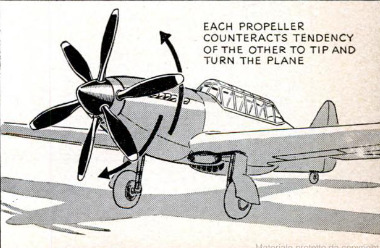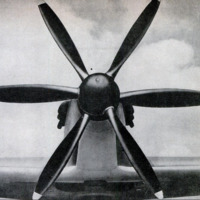Two propellers in tandem turning in opposite ways give warplanes new speed
Item
-
Title (Dublin Core)
-
Two propellers in tandem turning in opposite ways give warplanes new speed
-
Article Title and/or Image Caption (Dublin Core)
-
Title: Two propellers in tandem turning in opposite ways give warplanes new speed
-
extracted text (Extract Text)
-
TWIN PROPELLERS, whirling in oppo-
site directions on concentric shafts, are
an expected innovation on at least five ex-
perimental warplanes of 1942. Current re-
ports indicate that all leading U. S. propeller
makers are making the “contra-prop” air-
screws, and that they will boost cruising
speeds, to say nothing of maximum speeds,
well above the 400-mile-an-hour mark.
An Italian racing plane first used the
tandem-propeller system 12 years ago. Since
then, various designers have toyed with the
idea. But its large-scale adoption has awaited
present demand for motors of 2,000 horse-
power and upward.
“When horsepower increases,” explains
Robert J. Woods, designer of the Bell Aira-
cobra pursuit craft, “the plane requires
either a longer prop or more blades. Twelve
feet is pretty much the limit for prop di-
ameter, and more than four blades on a pro-
peller interfere with each other. So the next
thing for the engineer to do is to get two
propellers.” In addition, he points out, the
normal tendency of a single propeller to tip
the craft is counterbalanced by the opposite
rotation of the second one in the tandem ar-
rangement. Contra-prop installations may
be made not only on conventional plane
types but also on “pusher” designs with the
propellers behind the engine.
-
Language (Dublin Core)
-
Eng
-
Date Issued (Dublin Core)
-
1941-12
-
pages (Bibliographic Ontology)
-
111
-
Rights (Dublin Core)
-
Public domain
-
Archived by (Dublin Core)
-
Sami Akbiyik
 Popular Science Monthly, v. 139, n. 6, 1941
Popular Science Monthly, v. 139, n. 6, 1941




